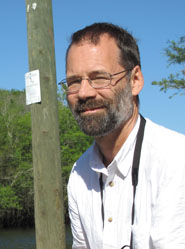Research
Interests
- Population Biology of Loggerhead Shrikes
- Population Genetics and Conservation of Seaside
Sparrows (With Stefan Woltmann, Kenzie Roeder and others)
- The function of bird song
- Biology of Odonata (Dragonflies and Damselflies)
Recent
and Current Research Projects
- Population fluctuations and movements of Loggerhead
Shrikes
- Diet and use of space by Loggerhead Shrikes (with
Katie Maddox, M.S. 2022)
- Use of urban habitats by Loggerhead Shrikes (with
Michelle Krauser, M.S. 2022)
- Breeding Biology of Urban Shrikes in the South
Carolina Coastal Plain (with Kyle Miles, undergraduate, and others)
- Using habitat to predict the distribution of three
sparrow species wintering in salt marshes (Kim Trinkle, M.S. 2013)
Selected
Courses Taught
|
Biological Science I, Biology
121
|
|
Biological Science II, Biology
122
|
|
Animal Behavior, Biology 436
|
|
Ornithology, Biology 461
|
|
|
Selected Publications
- Maddox, KA, Hill
CE
(2024) Use of space by urban Loggerhead Shrikes (Lanius ludovicianus)
as a window into habitat suitability. Journal of Field Ornithology
95(2). DOI
- Krauser MA, Hill
CE
(2023) Loggerhead Shrike occurrence along urban gradients in South
Carolina’s coastal plain. Urban Naturalist 10(1-14) .pdf
- Hill CE, Miles K, Maddox KA,
Tegeler A (2023) Are adoptions in a predatory songbird a strategy to aid
mate acquisition? Journal of Field Ornithology 94(2). DOI
- Woltmann S., Roeder M,
Xiong A, Hill C, Conway MH (2019) Additional Notes on Texas
Seaside Sparrows (Ammospiza
maritima sennetti): an update to Griscom 1948. Wilson Journal of
Ornithology 141:750-757.
- Roeder, MR, Hill,
CE,
Elphick, CS, Conway, M, Kocek, AR, Tegeler, A et al. (2021) Genetic data
disagree with described subspecies ranges for Seaside Sparrows on the
Atlantic coast. Ornithological Applications 123:1-14.
- Hill CE,
Ackay C, Campbell SE, Beecher MD (2011) Extrapair paternity, song, and
genetic quality in song sparrows. Behavioral Ecology 22:73-81 .pdf
- Hill CE
(2010) First record of California gull (Larus californicus) for South
Carolina. Chat 74: 102-103. .pdf
- Hill CE,
Gjerdrum C, Elphick CS (2010) Extreme levels of multiple mating
characterize the mating system of the saltmarsh sparrow Ammodramus caudacutus.
Auk 127: 300-307..pdf
Press:BBC
- Hill CE,
Tomko S, Hagen C, Schable N, Glenn T (2008) Novel microsatellite markers
for the saltmarsh sharp-tailed sparrow Ammodramus caudacutus (Aves:
Passeriformes) Molecular Ecology Resources 8: 113-115. Click for .pdf and corrected primer table
- Chan YL, Hill CE, Maldonado JE & Fleischer
RC (2006) Evolution and conservation of tidal marsh vertebrates:
molecular approaches. Studies in Avian Biology 32: 54-75 Click for .pdf and lit cited
- Hill CE,
Copenhaver KA, Gangler RK, Whaley JA (2005) Does light intensity
influence song output by Northern Mockingbirds? Chat 69: 61-67. Click
for .pdf
- Hill CE
and Post W (2005) Extra-pair paternity in Seaside Sparrows. Journal of
Field Ornithology 76: 119-126. Click for .pdf
- Hoekstra JM, Berrigan DM, Hoang A, Vigneri SN, Hill
CE, Beerli P & Kingsolver JG (2001) Strength and tempo of
directional selection in the wild. Proceedings of the National Academy
of Science of the USA 98: 9157-9160. Click for .pdf
- Kingsolver JG, Hoekstra HE, Hoekstra JM, Berrigan D,
Vigneri SN, Hill CE, Hoang A, Gilbert P & Beerli P (2001) The
strength of phenotypic selection in natural populations. American
Naturalist 157: 245-261 .pdf
- Hess CM, Gasper J, Hoekstra HE, Hill C , and
Edwards SV, 2000. MHC Class II Pseudogene and Genomic Signature of a
32-kb Cosmid in the House Finch (Carpodacus mexicanus ). Genome
Research 10: 613-623 .pdf
- Beecher MD, Campbell SE, Burt JM, Hill CE,
Nordby JC, 2000. Song type matching between neighboring song sparrows.
Animal Behaviour 59:21-27. .pdf
- Hill CE,
Campbell SE, Nordby JC, Burt JM, Beecher MD, 1999. Song sharing in two
populations of song sparrows (Melospiza melodia). Behavioral
Ecology and Sociobiology 46:341-349. .pdf
- Kroodsma DE, Byers BE, Halkin SL, Hill C ,
Minis D, Bolsinger JR, Dawson J-A, Donelan E, Farrington J, Gill F,
Houlihan P, Innes D, Keller G, Macaulay L, Marantz CA, Ortiz J, Stoddard
PK, Wilda K, 1999. Geographic variation of black-capped chickadee songs
and singing behavior in North America. Auk 116:387-402.
- Beecher MD, Nordby JC, Campbell SE, Burt JM, Hill
CE , O'Loghlen AL, 1997. What is the function of song learning in
songbirds? In: Perspectives in Ethology, Vol. 12: Communication (Owings
DH, Beecher MD, Thompson NS, eds). New York: Plenum Press; 77-97.
|

Chris Hill
Behavioral Ecology and Population Biology of Birds
BA
(1987) Massachusetts
M.S. (1995) Eastern Kentucky
Ph.D. (1999) Washington
Mailing Address:
Biology Department
Coastal Carolina University
P.O. Box 261954
Conway, SC 29528
Shipping Address (UPS etc.)
Douglas Hall 207
642 Century Circle
Conway, SC 29526
Tel: (843) 349-2567
E-mail:
chill@coastal.edu
|